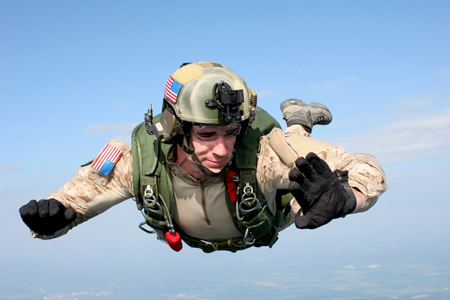Skydiving photography is a combination of two activities, photography and skydiving, because it cannot be undertaken from the ground and only in a limited manner from an aircraft. The latter is a potentially hazardous activity and the Society is not qualified to offer advice on safety aspects of the sport. Expert tuition, support and supervision is clearly required. However, it is probably true to say that the skydiving element of the activity must be mastered before creative elements are introduced. An inexperienced skydiver is, quite correctly, likely to be mainly concerned with achieving a safe landing. Only when the skydiving element is thoroughly practiced, and has become almost routine, can the skydiver hope to have the time and mental capacity to think about creating good images.
 |
| Public domain image courtesy of US Government |
Events take place at a very fast pace when falling from about 12,000 feet at 150 mph towards the ground. To have any hope of producing worthwhile images, a skydiver should therefore be familiar with the photographic equipment as well as the skydiving routines. It is also necessary to have experience of photography because there are no guaranteed ways to obtain good pictures. The diver must have an eye for a photograph, and know how to use light to its best advantage. Such knowledge is obtained mainly through experience.
Skydiving camera helmets are available with top and side mountings for cameras, and various safety devices such as audible warnings triggered by an altimeter. The helmets are designed to be adjustable for a tight fit so that they do not move on the head of the skydiver. They also have quick release mechanisms for eventualities such as landing in water. Housings for digital cameras are also available. Some skydivers use more than one camera, and may choose 35mm or medium format equipment. Cameras are normally equipped with a power winder and a glass Newton-ring sight of the type originally designed for military purposes.
The additional weight of equipment carried on the helmet can cause difficulties for a photographer. He may fall faster than the skydivers he is photographing, and the jarring effect of opening a parachute may cause neck injury. Older parachutes help to overcome this latter difficulty because they stretch with use and become more porous. This softens the impact upon opening.
The best skydiving images are arguably those taken close to the subject with wide-angle lenses. 35mm cameras fitted with 16mm, 24mm, 28mm or 35mm lenses are a popular choice. Focus can be pre-selected and the focus ring taped or otherwise fixed in place to prevent it being accidentally moved. Light tends to be intense so fast shutter speeds and relatively slow film (or low ISO settings) can be used. The slowest shutter speed normally used is probably about 1/500 sec. In most cases photographers try to plan for the Sun to be behind them, giving front lighting and good detail in the subject. However, back-lighting can be used to produce silhouettes to dramatic effect.






